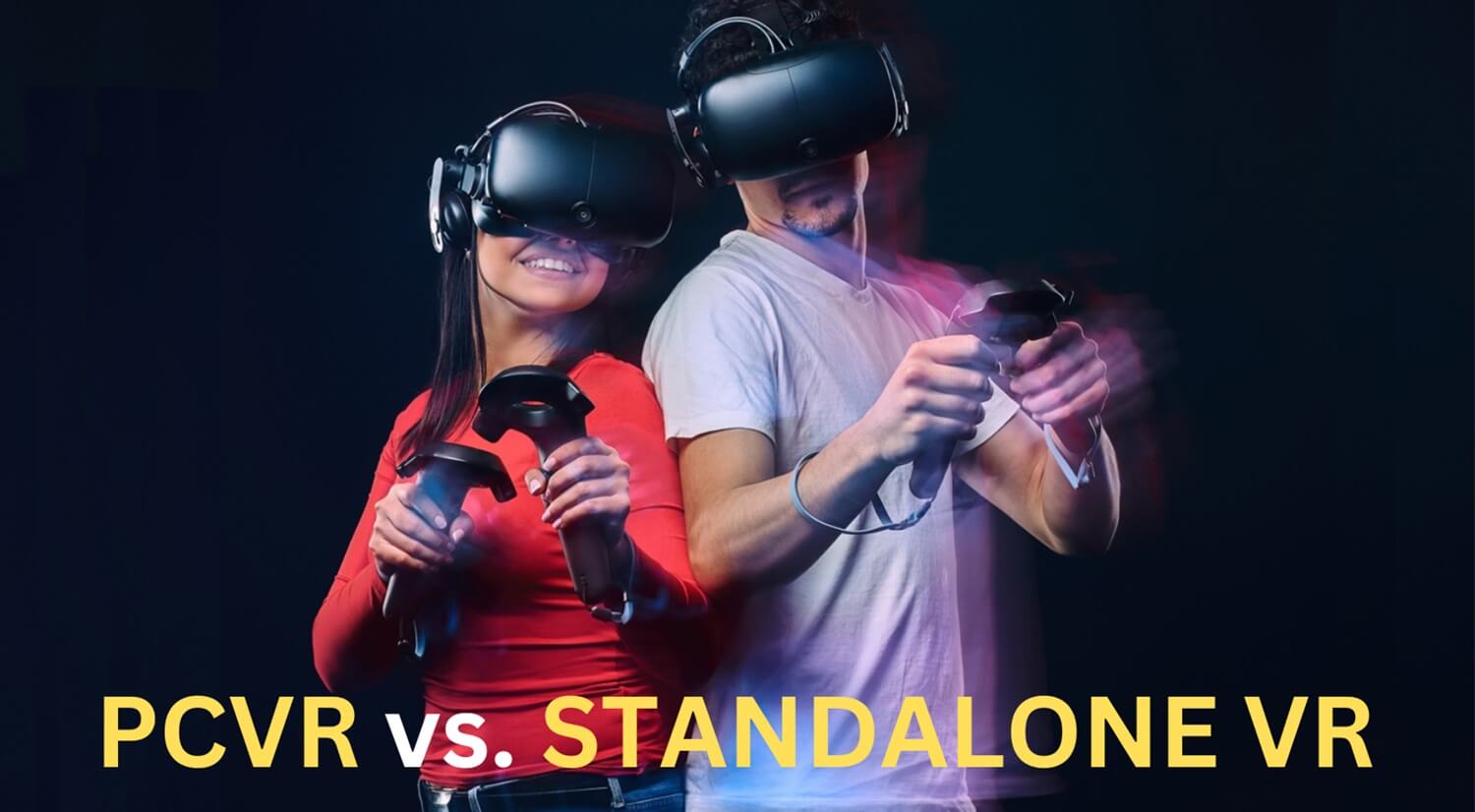Between a PCVR and a standalone VR headset, which should you go for? While the final decision on this will be based on personal decisions (individual preferences), this article provides some important points that can help you decide.
First off, standalone VRs typically can’t offer the same high-level performance as PC VRs due to hardware limitations. PC VRs come with more setup equipment; they aren’t as flexible and easy to set up as standalone VRs. Now, let’s discuss this in detail.

What is PC VR?
PC VR as the name implies, refers to a virtual reality headset designed to work with PCs. These VR headsets cannot be used without connecting them to a computer using the available connectivity options. To set up a PC VR, you need a well-equipped dedicated VR room. Usually, PC VRs offer more immersive experiences than standalone units.
But setting up PC VR is more cumbersome and you can only play when the headset is connected to the computer. Also, you need powerful computer hardware to get the best of a PC VR setup. In terms of pricing, PC VR can be much affordable, or very expensive, it all depends on the one you’re buying.
PC VR Headset Examples
1. Valve Index ($1,394.97 Full Kit)
Valve Index is a next-gen PC VR headset that offers stunning graphics quality and impressive performance with its well-advanced motion-tracking controllers. This PC VR literally has the best display resolution and refresh rate, but it’s also among the most expensive options in the market with a complex setup procedure.
2. HTC Vive ($799.00)
The HTC Vive is a pretty PC VR headset that sets the pace for others to follow. You need a decently specced computer to get the best out of an HTC Vive headset model. While this PC VR delivers an unrivaled virtual reality experience with crisp graphics, it requires a ton of free space around a room for its setup. There’s a standalone variant, the HTC Vive Focus 3, but it’s not as “impressive” as the PC VR models.
3. HP Reverb G2 ($548.00)
Reverb G2 from HP is one of the top players in the market when you talk of a PC VR headset. It offers fantastic audio and video quality with a pair of intuitive controllers that respond swiftly to your movements. The HP Reverb G2 offers a 90Hz refresh rate, not the best you may want, but still decent.
4. Oculus Rift S ( $289.00)
Oculus Rift S is a much more affordable PC VR headset that offers good display and immersive experiences. This headset uses an inside-out tracking system; the display resolution is 1280 x 1440 per eye with 80Hz refresh and 6 DoF tracking. The Oculus Rift S is only a mid-entry PC VR.
Advantages
- Offers more solid graphics and immersive experiences
- The best VR games are mainly available for PC VR headsets
- Offers more virtual reality features that may blow you away
- Higher display and availability of more accessories to enjoy your gameplay
Disadvantages
- Complex setup and inability to be moved from one place to another
- Usually more expensive than their standalone alternatives
- Requires powerful PC hardware for the best experience
System Requirements for PCVR
- Operating System: Windows 10 and above.
- Processor: At least an Intel Core i5-4590 or AMD FX 8350 or equivalent.
- Memory: At least 4GB RAM (Recommended 8GB RAM)
- Graphics Card: A NVIDIA GeForce GTX 970 or AMD Radeon R9 290 or equivalent.
- Connection Ports: USB 3.0
- Display Output: HDMI 1.3 or DisplayPort 1.2 or newer.
What is Standalone VR Headset?
Standalone VR is simply the opposite of PC VR. These are VR headsets built to fully function without being connected to a computer. These types of VR headsets come with built-in hardware and processors, so they can be set up anywhere. One big advantage of standalone VR is that you can carry the headset around with you and play anywhere you deem fit.
But standalone VRs are like mobile phones; while they may conceal monstrous specifications and resolution, they are no match to the performance of a standard computer, or in this case, a PC VR. Of course, you can enjoy many VR games on a standalone VR and access quite many impressive features, including ultra-wide FoV and high resolutions up to 90Hz.
Standalone VR Headset Examples
1. HTC Vive Focus 3 ($449.00 – $1,300.00)
The Vive Focus 3 is a direct alternative to HTC’s expensive PC VR headsets and it comes with good specs. This piece of all-in-one VT headset offers a dual-screen 5K resolution with a 90Hz refresh rate and 120-degree field of view (FOV). Vive Focus 3 is wireless, and while it offers a superior immersive experience, the display has a few dips here and there.
2. Oculus (Meta) Quest 2 ($248)
Literally the most popular and affordable standalone VR headset, the Oculus Quest 2 (Meta Quest 2) is inarguable one of the best standalone VR headsets to own. It also allows you access to Meta’s extensive and ever-growing library of VR games and apps.
Meta Quest 2 offers 6DoF, 1832 x 1920 pixel display per eye, 90 Hz, vivid visuals and smooth gameplay with the Gen 2 Qualcomm Snapdragon XR2 Platform, and 3D audio. Of course, there are higher-model Meta Quest VR headsets you can buy if you want to upgrade your standalone VR experience – the Meta Quest 3 and Meta Quest Pro.
3. Pico Neo ($499, not available in all countries)
Pico Neo headsets remarkably come with impressive features and are decently specced for premium experiences. You’re looking at standalone headsets with Qualcomm Snapdragon 845, 2048 x 2160 pixels per eye resolution, 101° FoV, and 75Hz refresh rate; might not be the best, but certainly acceptable and suitable for many VR games and applications.
Advantages
- Portability and flexibility, you can carry these headsets around
- Quite affordable
- Decently-specced with nicer aesthetics and build design than PC VRs
- Swift setup procedures
Disadvantages
- Limited graphics quality
- Typically does not offer better performance than PC VR headsets
Difference Between PCVR Standalone VR Headset
Here are the main differences between PC VR headsets and standalone VR headsets to help you make a better choice.
Graphics
Generally, PC VR headsets offer better and smoother graphics because they have “more” power – running off from computer hardware is definitely much better than whatever chipset a standalone VR may come with.
Tracking
The HTC Vive and Valve Index have the best tracking offered by a VR headset and they are both PC VRs. Because PC VR headsets come with more accessories, they deliver more precise tracking accuracy than standalone units.
Portability
Apparently, standalone units are “all-in-one” and still lightweight; they are easy to carry from one place to another, and you can set it up and play in any suitable space. PC VR headsets are not this flexible; once you set up a PC VR in a room, you can only play in that room – moving it to another room or location would be a lot of work, just like when you were running the initial setup.
Comfort
Both PC VR and standalone VR headsets offer good comfort and balance. There is no particular winner here; however, some PC VR headsets may feel uncomfortable if you wear them on for a long, but then, there are standalone VR headsets that feel the same way too.
Content
You’re getting more content (apps and games) with PC VR because of access to more VR platforms and app stores. Standalone VR headsets typically allow you access to the brand’s app store, and maybe, Steam.
Battery
Battery-wise, VR headsets offer variable battery life. However, most headsets would last for about 2.5 hours before requiring a charge. But, some PC VRs get their power from the connected PC or a battery pack – such PC VR headsets last longer than all-in-one standalone units.
Which VR Headset to Choose?
The final decision in choosing a VR headset is personal; you have to consider a lot of personal factors such as your budget, where you would want to set up the VR, and the available resources available to you. If you have a spare room for gaming, then a PC VR could be a good investment, but if your gaming space is small (just a side of your room), then you should go for a standalone unit.
Conclusion
Conclusively, PC VR and standalone VR are both good VR headsets, it all depends on your choice. The price and performance differences between these two VR headset types are forgivable, and there are different models available to compare.
